Text
[Blog #10] Spring 2023, Plath, Sexton and Lowell vs Olds, Flynn and Davis
Today, I am comparing and contrasting early Confessional poets -- Sylvia Plath’s “Lady Lazarus,” Anne Sexton’s “Wanting to Die” and Robert Lowell’s “Skunk Hour” -- to their Confessional contemporaries -- Sharon Olds’ “My Son the Man,” Nick Flynn’s “My Mother Contemplating Her Gun” and Olena Kalytiak Davis’ “Not This”.
For reference, confessional-style poetry or confessionalism is poetry that often incorporates first-person perspective to detail psychological struggles such as mental illness and/or childhood traumas.
Before I analyze the similarities and differences between those six poems, I would love to greet anyone who happens to stumble upon this blog post.
This is the link to my first blog post on Ada Limon’s The Carrying (2018):
My professor assigned a poetry book collection or individual poems every other week. My main objective was to dissect a few poems that left an impression on me while using his T.R.I.F.F.I.D. method.
Tone: the voice, mood, or attitude the reader believes the author is conveying through subject and word choice.
Rhythm: the pattern and beat between the stressed and unstressed word syllables.
Imagery: the details told through the five senses (touch aka physical, sound aka auditory, sight aka visual, taste aka gustatory and smell aka olfactory).
Figure: or figure of speech, is the non-literal expression of language. Figures of speech include hyperbole, irony, metaphor, simile, anaphora, antithesis and chiasmus.
Form: the way a poem is presented on paper or a screen. Think of how the author physically shapes the poem -- the use of dialogue, line spacing, paragraph breaks, rhythms and patterns.
Idea Density: how the author expresses their ideas throughout their poem. Can be literal (concrete) and/or figurative (vague or hidden).
Diction: the word choice and arrangement within a piece.
Part I:
The most noticeable difference between early and contemporary confessional poems are their forms. For example, both Sylvia Plath’s “Lady Lazarus” and Anne Sexton’s “Wanting to Die” have 3 lines per stanza, while Robert Lowell’s “Skunk Hour” has 6.
On the other hand, Sharon Olds’ “My Son the Man” is one long stanza compose of 15 lines; Nick Flynn’s “My Mother Contemplating Her Gun” is a bit harder to deduce where a stanza starts and end, but it seems to vary between 1–3 lines per stanza. Olena Kalytiak Davis’ “Not This” starts at 2 lines, then 11, and shifts back to 2 lines for the last three stanzas.
Part II:
I feel as though I can’t quite compare and contrast the early and contemporary poets’ idea density because they all similarly discuss mental health awareness/topics. Plath’s “Lady Lazarus” (Lazarus means a person who is resurrected from the dead) reveals the narrator’s (Plath’s) third suicide attempt by age thirty:
I have done it again.
One year in every ten
I manage it——
(...)
And I a smiling woman.
I am only thirty.
And like the cat I have nine times to die.
This is Number Three.
What a trash
To annihilate each decade. (1-3, 21-24)

Lowell’s “Skunk Hour” the narrator admits to his declining mental health -- feeling crazy, alone and depressed, so much so, he compared his state of mind to Hell:
My mind’s not right.
A car radio bleats,
“Love, O careless Love. . . .” I hear
my ill-spirit sob in each blood cell,
as if my hand were at its throat. . . .
I myself am hell;
nobody’s here— (30-36)
Sexton’s “Wanting to Die” is vaguely similar in topic to Plath as they both discuss “suicide,” though Sexton is more on the nose than Plath. In reference to the title, the narrator confesses to her desire to commit suicide:
Since you ask, most days I cannot remember.
I walk in my clothing, unmarked by that voyage.
Then the almost unnameable lust returns.
Even then I have nothing against life.
I know well the grass blades you mention,
the furniture you have placed under the sun.
But suicides have a special language.
Like carpenters they want to know which tools.
They never ask why build. (1-9)
Olds’ “My Son the Man” the narrator confesses that she is afraid of her son growing up and becoming his own person outside of her control/influence (maternal fears).

She compares herself to the chains strapped on Houdini, while her son is compared to Houdini himself:
Suddenly his shoulders get a lot wider,
the way Houdini would expand his body
while people were putting him in chains. It seems
no time since I would help him to put on his sleeper,
guide his calves into the gold interior,
zip him up and toss him up and
catch his weight. I cannot imagine him
no longer a child, and I know I must get ready,
get over my fear of men now my son
is going to be one. This was not
what I had in mind when he pressed up through me like a
sealed trunk through the ice of the Hudson,
snapped the padlock, unsnaked the chains,
and appeared in my arms. Now he looks at me
the way Houdini studied a box
to learn the way out, then smiled and let himself be manacled. (1-15)
Eventually, like all traps, Houdini figures them out and escapes, which is what the narrator fears her son will do to her when he matures.
Again, Flynn’s “My Mother Contemplating Her Gun” is similar to Plath and Sexton’s poems as it deals with the topic of suicide; as the title implies, the narrator is the mother.
Throughout the poem, the mother discusses the gun -- the act of suicide -- as insignificant or easy by down-playing the severity and adding colorful descriptions to the gun:
I bought it
when I didn’t feel safe. The barrel
is oily,
reflective, the steel
pure, pulled from a hole
in West Virginia. It
could have been cast into anything, nails
along the carpenter’s lip, the ladder
to balance the train. Look at this, one
bullet,
how almost nothing it is—
saltpeter sulphur lead Hell
burns sulphur, a smell like this.
safety & hammer, barrel & grip
I don’t know what I believe. (9-23)
Lastly, in Davis’ “Not This,” the narrator reveals she regrets not appreciating the little moments of family time in the past since the family dynamic has change -- the children growing up and the narrator (possibly) falling out of love with their spouse:
i raised my kids, they
grew i lost two pasts–i am
not made of them and they
are through.
we forget what
we remember:
each of the five
the fevered few
days we used to
fall in love. (10-19)

What did I learn?
The most noticeable difference between early and contemporary confessional poems are their forms; early poets stuck to a rigid line count, while their successors are more free-flowing.
Moreover, they all discuss mental health issues. Plath, Sexton and Flynn explore suicide in their poetry; Lowell, Olds and Davis wrote about varying topics: solitude, maternal fears and regret.
Whether early or contemporary, not all poets write about the same mental issues; even if two poets wrote about the same mental illness, they have differing voices, imagery, figures of speeches, etc.
Though, most confessional poets seem to share the same tone: melancholy, desolate, grim, mournful and pessimistic.
Spotlight Poet: Who is Sylvia Plath?
Some may only know Sylvia Plath by how she infamously died, rather than how she lived her life. I am here to correct that! Boston native Sylvia Plath specialized and was highly noted for her confessional poetry; her topics ranged from her mental struggles, self-image and familial and marital traumas. During her lifetime, Plath published two poetry collections: The Colossus and Other Poems (1960) and Ariel (1965).
One of her most well-known and studied poems is “Lady Lazarus” and “Daddy”. In the former, as discussed earlier, Plath confesses to her third suicide attempt, whereas in the latter, she recounts her patriarchal sufferings through her father’s death and the conflicting relationship with her husband (poet Ted Hughes).
In the end, Sylvia Plath’s poetry remained timeless and praised by her contemporaries and successors because of how relatable and descriptive her thoughts and emotions -- anguish, alienation and self-destruction -- are to the past and present literary communities.
For more information on confessionalism and poetry by Plath, Sexton, Lowell, Olds, Flynn and Davis, check out the links below:
Lastly, what are some of your favorite confession-style poems?
Feel free to share some below!
#poetry review#poetry book#poetry recs#Sylvia Plath#Anne Sexton#Robert Lowell#poems#early poetry#contemporary poetry#sharon olds#nick flynn#olena kalytiak davis#confessional poetry
6 notes
·
View notes
Text
[Blog #9] Spring 2023, Whitman and Dickinson vs Gay and Soldier
Today, I am comparing and contrasting 19th Century Romantic-style poets -- Walt Whitman’s “Out of the Cradle Endlessly Rocking” and Emily Dickinson’s “After Great Pain, a Formal Feeling Comes” -- to their Romantic-style contemporaries -- Ross Gay’s “Opera” and Layli Long Soldier’s “Whereas”.
For reference, romantic-style poetry or romanticism is poetry that lean towards emotions, nature, imagination and individualism.
Before I analyze the similarities and differences between those four poems, I would love to greet anyone who happens to stumble upon this blog post.
This is the link to my first blog post on Ada Limon’s The Carrying (2018):
My professor assigned a poetry book collection or individual poems every other week. My main objective was to dissect a few poems that left an impression on me while using his T.R.I.F.F.I.D. method.
Tone: the voice, mood, or attitude the reader believes the author is conveying through subject and word choice.
Rhythm: the pattern and beat between the stressed and unstressed word syllables.
Imagery: the details told through the five senses (touch aka physical, sound aka auditory, sight aka visual, taste aka gustatory and smell aka olfactory).
Figure: or figure of speech, is the non-literal expression of language. Figures of speech include hyperbole, irony, metaphor, simile, anaphora, antithesis and chiasmus.
Form: the way a poem is presented on paper or a screen. Think of how the author physically shapes the poem -- the use of dialogue, line spacing, paragraph breaks, rhythms and patterns.
Idea Density: how the author expresses their ideas throughout their poem. Can be literal (concrete) and/or figurative (vague or hidden).
Diction: the word choice and arrangement within a piece.
Part I:












In terms of similarities, both Walt Whitman’s “Out of the Cradle Endlessly Rocking” and Ross Gay’s “Opera” share a sorrowful tone that transitions into hopeful by the end. For example, in Whitman’s poem, the narrator states:
O past! O happy life! O songs of joy!
In the air, in the woods, over fields,
Loved! loved! loved! loved! Loved!
But my mate no more, no more with me!
We two together no more. (Whitman)
Here, the sorrow is conveyed through one of the narrator’s (a bird) sings for the return of the past -- being with their lover -- because in the current day, it is implied that their lover left them (in death or break up).

In Gay’s “Opera”, the narrator says:
Today my heart is so goddamned fat with grief
that I've begun hauling it in a wheelbarrow.
(...)
I'm sad. (Gay 1-2 & 8)
The sorrow is outright mentioned when that narrator says, “I’m sad,” rather than implied like Whitman’s.
Part II:
Moreover, in both poems, the tone shifts to hopeful and upbeat after the narrator encounters a mystique or (almost) supernatural character. In Whitman’s, the boy narrator listens to the bird narrator’s song of grief, which triggers an emotional moment and self-revelation for the boy:
O you singer solitary, singing by yourself, projecting me,
O solitary me listening, never more shall I cease perpetuating you,
(...)
My own songs awaked from that hour,
And with them the key, the word up from the waves,
The word of the sweetest song and all songs. (Whitman)
Though it is not implied what the boy narrator’s “own song” symbolized, I believe the song represented the boy maturing into a man as seen by the first stanza, “A man, yet by these tears a little boy again, / (...) A reminiscence sing” (Gay 19 & 23).

The first stanza is the current day or flash-forward of the boy narrator’s life. His sentimental feelings “A man, yet by these tears a little boy again” towards this “reminiscence sing” proves its major impact on his childhood -- emotional passion.
In Gay’s poem, the narrative became cheerful and jovial upon hearing a woman sing opera during a stroll:
I will be slogging through the obscure country of my sadness
in all its monotone flourish, and so imagine my surprise
when my self-absorption gets usurped
by the sound of opera streaming from an open window,
and the sun peeks ever-so-slightly from behind his shawl,
and this singing is getting closer,
(...)
it was heaven sailing from her mouth and all the fish in the sea
and giraffe saunter and sugar in my tea and the forgotten angles
of love and every name of the unborn and dead
from this abuelita only glancing at me
(...)
let me stop here
and tell you I said thank you. (Gay)
Here, the narrator was stunned and awestruck by the opera singer; similar to Whitman, the narrator experienced a rebirth or a revelation just by listening and looking:
all the fish in the sea
and giraffe saunter and sugar in my tea and the forgotten angles
of love and every name of the unborn and dead
from this abuelita only glancing at me. (Gay)
This chance meeting, in turn, inspired hope within the narrator, judging by the last line when the narrator thanks the singer: “let me stop here / and tell you I said thank you” (Gay).

Part III:





In terms of differences, earlier romanticism poems such as Whitman’s “Out of the Cradle Endlessly Rocking” and Emily Dickinson’s “After Great Pain, a Formal Feeling Comes” differs greatly in form from contemporary poems such as Ross Gay’s “Opera” and Layli Long Soldier’s “Whereas”.
In Whitman and Dickinson pieces, both poets rarely pack their stanza: Dickinson’s poem is three short stanzas long with 4–5 lines each, whereas Whitman’s is 39 stanzas long. Except for two stanzas that have more than 10 lines each, Whitman’s stanzas are relatively curt (about 2–6 lines long).
On the other hand, Gay’s “Opera Singer” only has two stanzas; the first has 8 lines, while the second uses 32 lines. Soldier’s “Whereas” offers a middle-ground between the short stanzas of the forebear poets and the longer stanzas of her peers. Soldier’s poem has 20 stanzas: 17 short stanzas (1-4 lines) and 3 large (prose poetry) stanzas.
What did I learn?
The shift in incorporating larger stanzas and/or prose within poetry could be due to many contemporary poets experimenting and breaking the conventional romanticism rules of their forebears -- making their own style.
For more information on romanticism and poetry by Whitman, Dickinson, Gay and Soldier, check out the links below:
Lastly, what are some of your favorite romantic-style poems?
Feel free to share some below!
#poetry review#poetry book#poetry recs#poems#romanticism#romantic poetry#layli long soldier#Ross Gay#walt whitman#emily dickinson#early poetry#contemporary poetry
0 notes
Text
[Blog #8] Spring 2023, Carol Ann Duffy (Part 2)
This week, I will be analyzing Carol Ann Duffy’s poem, “Words, Wide Night”.
Before I start, I would love to greet anyone who happens to stumble upon this blog post.
This is the link to my first blog post on Ada Limón’s The Carrying (2018):
My professor assigned a poetry book collection or individual poems every other week. My main objective was to dissect a few poems that left an impression on me while using his T.R.I.F.F.I.D. method.
Tone: the voice, mood, or attitude the reader believes the author is conveying through subject and word choice.
Rhythm: the pattern and beat between the stressed and unstressed word syllables.
Imagery: the details told through the five senses (touch aka physical, sound aka auditory, sight aka visual, taste aka gustatory and smell aka olfactory).
Figure: or figure of speech, is the non-literal expression of language. Figures of speech include hyperbole, irony, metaphor, simile, anaphora, antithesis and chiasmus.
Form: the way a poem is presented on paper or a screen. Think of how the author physically shapes the poem -- the use of dialogue, line spacing, paragraph breaks, rhythms and patterns.
Idea Density: how the author expresses their ideas throughout their poem. Can be literal (concrete) and/or figurative (vague or hidden).
Diction: the word choice and arrangement within a piece.
Carol Ann Duffy’s “Words, Wide Night” (1990):

As demonstrated by Carol Ann Duffy’s poem, “Words, Wide Night,” I favor the lack of rules the free verse style offers. In terms of form, Duffy’s poem is split into four stanzas: the first has three lines, the second has three, the third has two, and the fourth has one.
Somewhere on the other side of this wide night
and the distance between us, I am thinking of you.
The room is turning slowly away from the moon.
This is pleasurable. Or shall I cross that out and say
it is sad? In one of the tenses I singing
an impossible song of desire that you cannot hear.
La lala la. See? I close my eyes and imagine the dark hills I would have to cross
to reach you. For I am in love with you
and this is what it is like or what it is like in words.
In the first line of the third stanza, Duffy completely disregards the lengths of the previous lines and does a line break much later on. This longer line offers a visual distance the narrator is conveying through her yearning: “imagine the dark hills I would have to cross” (Duffy 7).

Even the fourth stanza could have easily been a part of the third stanza, but Duffy decided to separate them to further emphasize the distance between the two lovers as well as add a ‘reflection’ moment.
Her stating, “and this is what it is like or what it is like in words” (9) establishes a different feeling from the rest of the poem.
Stanza one to three is Duffy explaining her desire to see her lover, but stanza four is her signaling the audience the poem is finished -- this is what it feels like to yearn and now my reflection is over.
Part II:
For imagery, Duffy weaves between visual imagery and literal thought. In the first stanza, she states:
Somewhere on the other side of this wide night
and the distance between us, I am thinking of you.
The room is turning slowly away from the moon. (Duffy 1-3)
Visually-speaking, the reader can imagine two lovers separated in the darkness of the vast night, and one of their rooms leaving the moonlight.

In the next stanza, Duffy showcases her deepest thoughts as if she is speaking to her distance lover:
This is pleasurable. Or shall I cross that out and say
it is sad? In one of the tenses I singing
an impossible song of desire that you cannot hear (Duffy 4-6).
Here, Duffy words feel unrefined, unscripted and natural, as if she was writing her feelings on the spot. This is evident by the narrator switching between feeling “pleasurable” to “sad,” showcasing Duffy stream of consciousness while writing and how quick emotions can change.
Who is Carol Ann Duffy?
I gushed about her greatness in my previous blog. Feel free to check it out:
For reference, Duffy won numerous prestigious poetry awards including the Somerset Maugham Award, Whitbread Poetry Award and T. S. Eliot Prize. She was also the Poet Laureate of the United Kingdom for 10 years before her resignation (2009-2019).
For more information and poetry by Duffy, check out the links below:
Lastly, what are some of your favorite free verse poems?
Feel free to share some below!
0 notes
Text
[Blog #7] Spring 2023, Carol Ann Duffy (Part 1)
Beginning this week, I will be showcasing what I have learned from my Literature from the Writer’s Perspective course in Spring 2023. This course was taught by my Contemporary Poetry Seminar professor, so the T.R.I.F.F.I.D. method is still implemented in my analysis.
Today, I am dissecting one of my favorite poems, “Valentine” by Carol Ann Duffy.
Before I start, I would love to greet anyone who happens to stumble upon this blog post.
This is the link to my first blog post on Ada Limón’s The Carrying (2018):
My professor assigned a poetry book collection or individual poems every other week. My main objective was to dissect a few poems that left an impression on me while using his T.R.I.F.F.I.D. method.
Tone: the voice, mood, or attitude the reader believes the author is conveying through subject and word choice.
Rhythm: the pattern and beat between the stressed and unstressed word syllables.
Imagery: the details told through the five senses (touch aka physical, sound aka auditory, sight aka visual, taste aka gustatory and smell aka olfactory).
Figure: or figure of speech, is the non-literal expression of language. Figures of speech include hyperbole, irony, metaphor, simile, anaphora, antithesis and chiasmus.
Form: the way a poem is presented on paper or a screen. Think of how the author physically shapes the poem -- the use of dialogue, line spacing, paragraph breaks, rhythms and patterns.
Idea Density: how the author expresses their ideas throughout their poem. Can be literal (concrete) and/or figurative (vague or hidden).
Diction: the word choice and arrangement within a piece.
Carol Ann Duffy’s “Valentine” (1993):

Carol Ann Duffy’s poem, “Valentine,” incorporates several figures of speech such as alliteration, consonance, rhyme, assonance, simile, metaphor, personification and anaphora in order to appear as a typical love poem -- sounding looking and sounding rhythmically pleasing.
For alliteration, Duffy mentions three: “red rose” (line 1), “cute card” (line 12) and “light like” (line 4-5).

Lines 4-5 and 14 are consonances: “light like” and “Its fierce kiss will stay on your lips”.
On the other hand, line 22 features an assonance: “Its scent will cling to your fingers”.
Line 14 contains a slant rhyme between “kiss” and “lips”.
Also, Duffy’s poem incorporates two similes: “It will blind you with tears like a lover” (line 7-8) and “It promises light like the careful undressing of love” (4-5).
However, there is only one metaphor present: “It is a moon wrapped in brown paper” (line 3).
In addition, there are two usages of personification, since an onion cannot perform human actions: “It promises light” (line 4) and “Its fierce kiss will stay on your lips” (line 14).
Moreover, Duffy uses several anaphoras throughout her poem. For example, the “Not a” phrase is repeated two times: “Not a red rose or a satin heart” (line 1) and “Not a cute card or a kissogram” (line 12).
The “I give you an onion” phrase is used in lines 2 and 13.
The “It will” phrase appears twice: “It will blind you with tears like a lover” (line 7-8) and “It will make your reflection a wobbling photo of grief” (line 9-10).
Lastly, the “Its” phrase is repeated three times: “Its fierce kiss will stay on your lips” (line 14), “Its platinum loops shrink to a wedding ring” (line 19), and “Its scent will cling to your fingers” (line 22).

Though Duffy’s poem offers negative commentary on the commodification of romantic love, the poem still functions as a love poem if the reader replaces the central subject, “onion”, with something more aesthetically and stereotypically loving and cute -- for example, chocolate.
Some elements would need to be reworded or deleted (such as the phrase ‘Not a’), however, most figures of speech can remain unchanged such as the alliteration and assonance.
Part II:
As mentioned, Duffy’s poem is dense with its subtle ideas on the commercialization of Valentine's Day and romantic love in general. Lines 1 and 12 perfectly illustrate Duffy’s message: “Not a red rose or a satin heart” and “Not a cute card or a kissogram”.
Furthermore, Duffy’s Valentine gift, an onion, represents the societal perception of the perfect romantic lover -- the worth of one’s love can only be showcased through a price. Her poem, on the other hand, disproves this materialistic/consumerist perspective by showcasing how love can be displayed through anything (even an onion).

Part III:
Lastly, in terms of form, Duffy’s “Valentine” consists of four stanzas (excluding the three individual lines). In narrative, the poem is split between 4 major moments of a romantic relationship (some people may have) -- dating (getting to know), disagreements/complications, commitment and marriage (long-term). For instance, the first stanza states:
I give you an onion.
It is a moon wrapped in brown paper.
It promises light
like the careful undressing of love. (line 2-5)
Here, this first stanza marks the beginning of a romantic relationship. In particular, the phrase “It promises light / like the careful undressing of love” (line 4-5) represents the dating stage; Duffy correlates the undressing of an onion’s outer skin to potential lovers familiarizing themselves with one another through compatibility tests (dating, chemistry, 20 questions, etc.).
The second stanza mentions:
Here.
It will blind you with tears
like a lover.
It will make your reflection
a wobbling photo of grief. (line 6-10)
In other words, the second stanza marks the trial and tribulations of maintaining a romantic relationship. To me, the phrase “It will make your reflection / a wobbling photo of grief” means love will have its ‘ups and down,’ specifically the ‘downs’. After the dating phase (getting comfortable), lovers tend to discover the cracks in their partnership (i.e. disagreements, fights, insecurities, etc.); similar to how an onion can cause tears, love can also produce sadness.

The third stanza states:
I give you an onion.
Its fierce kiss will stay on your lips,
possessive and faithful
as we are,
for as long as we are. (line 13-17)
Here, the third stanza focuses on the commitment aspect of a relationship. Duffy compares the taste of the onion -- “possessive and faithful” (line 15) -- to lovers that are willing to stay together.
Lastly, the fourth stanza mentions:
Take it.
Its platinum loops shrink to a wedding ring,
if you like.
Lethal.
Its scent will cling to your fingers,
cling to your knife. (line 18-23)
In other words, Duffy’s final stanza marks the union between lovers; a careful continuous cut of an onion resembles a ring and the smell of an onion tends to stay if one does not properly wash it off. Duffy uses the shredded onion skin and smell as a metaphor for marriage and devotion, since a wedding ring wraps around fingers like the scent of an onion.

Who is Carol Ann Duffy?
Arguably, one of the best living poets, Scotland native Carol Ann Duffy has been interweaving topics such as feminism (gender issues), LGBT, and romance since her debut poetry collection, Fleshweathercock and Other Poems (1974), at just 19 years-old.
In 1983, Duffy received national recognition after winning the National Poetry Competition, but her accolades did not stop there. In the years following, Duffy became the recipient of numerous awards and prizes such as the Eric Gregory Award, Somerset Maugham Award, Scottish Arts Council Book Award, Ted Hughes Award, etc.
In 1993, Duffy challenged the standard love poem when her “Valentine” poem was published (Mean Time poetry collection) (Scottish Poetry Library, n.d.). Along with showcasing differing poetic elements, Duffy’s “Valentine” conveys the various stages of a romantic relationship as well as the commodification (consumerism and materialism) of love through the properties of an onion.
For more information and poetry by Duffy, check out the links below:
Lastly, what are some of your favorite love poems?
Feel free to share some below!
0 notes
Text
[Blog #6] Fall 2022, Gay, Lockwood & Tate
This week, I am comparing and contrasting 3 individual poems – Ross Gay’s “Opera Singer,” Patricia Lockwood’s “The Hypno-Domme Speaks, and Speaks and Speaks” and James Tate’s “The List of Famous Hats” – by using my professor’s T.R.I.F.F.I.D. method
Before I analyze the similarities and differences between those three poems, I would love to greet anyone who happens to stumble upon this blog post.
This is the link to my first blog post on Ada Limón's The Carrying (2018):
My Contemporary Poetry Seminar professor assigned a poetry book collection or individual poems every other week. My main objective was to dissect a few poems (4-5) that left an impression on me while using his T.R.I.F.F.I.D. method.
Tone: the voice, mood, or attitude the reader believes the author is conveying through subject and word choice.
Rhythm: the pattern and beat between the stressed and unstressed word syllables.
Imagery: the details told through the five senses (touch aka physical, sound aka auditory, sight aka visual, taste aka gustatory and smell aka olfactory).
Figure: or figure of speech, is the non-literal expression of language. Figures of speech include hyperbole, irony, metaphor, simile, anaphora, antithesis and chiasmus.
Form: the way a poem is presented on paper or a screen. Think of how the author physically shapes the poem -- the use of dialogue, line spacing, paragraph breaks, rhythms and patterns.
Idea Density: how the author expresses their ideas throughout their poem. Can be literal (concrete) and/or figurative (vague or hidden).
Diction: the word choice and arrangement within a piece.
Our first focus is Ross Gay’s “Opera Singer” (2011):


The tone in Ross Gay’s poem, “Opera Singer,” starts as sadness for about one-third of the poem, and morphs into a solace/uplifting voice in the latter two-thirds. For example, in the first stanza, the narrator relays his sadness through multiple similes and images and even out-right says he is sad:
Today my heart is so goddamned fat with grief
that I’ve begun hauling it in a wheelbarrow. No. It’s an anvil
dragging from my neck as I swim
through choppy waters swollen with the putrid corpses of hippos,
which means lurking, somewhere below, is the hungry
snout of a croc waiting to spin me into an oblivion
worse than this run-on simile, which means only to say:
I’m sad. And everyone knows what that means. (8)
However, in the latter two-thirds of the poem, there is a noticeable shift in the narrator’s tone once he mentions the opera singer -- he is using bright, colorful, and happy images. He even notes how thankful he was to experience this comforting moment -- fully uplifting his once sad/depress voice:

so imagine my surprise
when my self-absorption gets usurped
by the sound of opera streaming from an open window,
and the sun peeks ever-so-slightly from behind his shawl,
and this singing is getting closer, so that I can hear the
delicately rolled r’s like a hummingbird fluttering the tongue
which means a language more beautiful than my own,
and I don’t recognize the song
[…]
from this abuelita only glancing at me
before turning back to her earnest work of brushstroke and lullaby
and because we all know the tongue’s clumsy thudding
makes of miracles anecdotes let me stop here
and tell you I said thank you. (13-40)


On the other hand, Patricia Lockwood’s poem, “The Hypno-Domme Speaks, and Speaks and Speaks,” conveys a powerful and confident tone through her self-assured claims and commands:
What do I have, I have absolute
power, and what I want is your money, your drool,
and your mind, and the sense of myself as a snake,
and a garter in the grass. Every bone in the snake
is the hipbone, every part of the snake is the hips.
The first sound I make is silence, then sssssshhh,
the first word I say is listen.
[...]
Believe you
are a baby till I tell you otherwise, then believe
you’re a man till I tell you you’re dirt. When a gunshot
rings out you’ll lie down like you’re dead. When you
hear, “He is breathing,” you’ll stand up again.
The best dog of the language is Yes and protects you. (22-27)
In other words, the narrator gives this goddess/enchantress image: she can manipulate anyone into being her personal servant and demean them by remarking them as lesser (baby, dirt, dog). It was only after reading the poem that I fully understood what the title is referring to -- ‘hypno-domme’ must be short for hypnotizing-dominatrix.

Lastly, in James Tate’s poem, “The List of Famous Hats,” the narrator adopts a playful tone through his whimsical reimagining of Napoleon and his iconic hat:
I am thinking of his private bathing cap, which in all honesty wasn't much different than the one any jerk might buy at a corner drugstore now, except for two minor eccentricities. The first one isn't even funny: Simply it was a white rubber bathing cap, but too small. Napoleon led such a hectic life ever since his childhood, even farther back than that, that he never had a chance to buy a new bathing cap and still as a grown-up--well, he didn't really grow that much, but his head did: He was a pinhead at birth, and he used, until his death really, the same little tiny bathing cap that he was born in. (1-10)
Here, the narrator’s playful tone is marked by his focus on a trivial concept -- Napoleon’s hypothetical bathing cap. His poem is obviously a jest toward Napoleon’s infamous short stature and Tate does so by implying that Napoleon’s tricorn hat symbolized his actual head shape: “My theory is simple-minded to be sure: that beneath his public head there was another head and it was a pyramid or something” (11-15).

What have I learned from all three poems?
Overall, in my opinion, all the poems had varying tone(s). Gay’s was both somber and comforting, Lockwood’s was commanding and dominating while Tate’s was playful and unserious.
Their differing tones make sense in context of their topics. Gay’s poem was about someone overcoming grief, Lockwood’s narrator is a confident dominatrix, and Tate’s poem is making fun of Napoleon’s height.
Gay (1974) and Lockwood (1982) were born in the same generation while Tate (1943) was their predecessor (passed away in 2015).
Why should you read more of their works?
Gay’s Awards and Honors:
2015 National Book Award for Poetry, finalist
2016 National Book Critics Circle Award for Poetry
2016 Kingsley Tufts Poetry Award
Lockwoods’ Awards and Honors:
2014 New York Times Notable Book.
2017 Thurber Prize for American Humor
2021 Dylan Thomas Prize
Tate’s Awards and Honors:
1966 Yale Series of Younger Poets
1969 & 1979 National Endowment for the Arts Literature Fellowship in Poetry
1974 National Institute of Arts and Letters Award
1976 Guggenheim Fellowship
1992 Pulitzer Prize for Poetry
1994 National Book Award for Poetry
1995 Academy of American Poets Wallace Stevens Award
2004 Member of the American Academy of Arts and Letters
For more information and poetry by Gay, Lockwood and Tate, check out the links below:
Lastly, is there a poem that makes you cry, laugh or contemplate life?
Feel free to share some below!
0 notes
Text
[Blog #5] Fall 2022, Bishop, Limón & Stevens
Beginning this week, I will be reviewing individual poems rather than collections. My Contemporary Poetry Seminar professor only assigned 4 poetry books for that course; the rest were individual poems.
Today, I am comparing and contrasting Elizabeth Bishop’s “The Fish,” Ada Limón's “The Conditional” and Wallace Stevens’ “Thirteen Ways of Looking at a Blackbird,” by using my professor’s T.R.I.F.F.I.D. method
Before I analyze the similarities and differences between those three poems, I would love to greet anyone who happens to stumble upon this blog post.
This is the link to my first blog post on Ada Limón's The Carrying (2018):
My Contemporary Poetry Seminar professor assigned a poetry book collection or individual poems every other week. My main objective was to dissect a few poems (4-5) that left an impression on me while using his T.R.I.F.F.I.D. method.
Tone: the voice, mood, or attitude the reader believes the author is conveying through subject and word choice.
Rhythm: the pattern and beat between the stressed and unstressed word syllables.
Imagery: the details told through the five senses (touch aka physical, sound aka auditory, sight aka visual, taste aka gustatory and smell aka olfactory).
Figure: or figure of speech, is the non-literal expression of language. Figures of speech include hyperbole, irony, metaphor, simile, anaphora, antithesis and chiasmus.
Form: the way a poem is presented on paper or a screen. Think of how the author physically shapes the poem -- the use of dialogue, line spacing, paragraph breaks, rhythms and patterns.
Idea Density: how the author expresses their ideas throughout their poem. Can be literal (concrete) and/or figurative (vague or hidden).
Diction: the word choice and arrangement within a piece.
Our first subject is Elizabeth Bishop’s “The Fish” (1946):



Elizabeth Bishop’s “The Fish” leans on visual imagery to create an air of mystique, wonder, and empathy for the titled fish.
For example, we are shown visuals through the metaphors and environmental resemblances Bishop utilizes to describe the fish in intricate details:
He hung a grunting weight,
battered and venerable
and homely. Here and there
his brown skin hung in strips
like ancient wallpaper,
and its pattern of darker brown
was like wallpaper:
shapes like full-blown roses
stained and lost through age.
He was speckled with barnacles,
fine rosettes of lime,
and infested
with tiny white sea-lice,
and underneath two or three
rags of green weed hung down. (9-21)

Here, Bishop incorporates these visuals such as ‘ancient wallpaper’ and environmental infestations to show how long said fish spent in the water-- its survival until the narrator captured it.

Ada Limón's “The Conditional” (2020) uses visual imagery to transform every day/known objects into outlandish metaphors to convey a sense of ‘staying together’ no matter how crazy/apocalyptic life becomes.
For example, Limón shows us the visual images through the bizarre ‘what ifs’/outcomes of a known entity/idea (non-human) such as the moon and the sun:
Say tomorrow doesn't come.
Say the moon becomes an icy pit.
Say the sweet-gum tree is petrified.
Say the sun's a foul black tire fire.
Say the owl's eyes are pinpricks.
Say the raccoon's a hot tar stain.
Say the shirt's plastic ditch-litter.
Say the kitchen's a cow's corpse. (1-8)
It is in these visual images of these known and transformed concepts that we are encouraged to see the world differently.



Though Wallace Stevens’ “Thirteen Ways of Looking at a Blackbird” (1917) conveys visual imagery, it also incorporates many indescribable/indefinite ideas that give the poem a realistic, grounded feeling.

For example, we are given big concepts such as minds and beauty in between the visual imagery of the blackbird or the environmental:
I
Among twenty snowy mountains,
The only moving thing
Was the eye of the blackbird.
II
I was of three minds,
Like a tree
In which there are three blackbirds.
III
The blackbird whirled in the autumn winds.
It was a small part of the pantomime.
IV
A man and a woman
Are one.
A man and a woman and a blackbird
Are one.
V
I do not know which to prefer,
The beauty of inflections
Or the beauty of innuendoes,
The blackbird whistling
Or just after. (1-17)
What have I learned from all three poems?
Overall, I believe Bishop and Limón's poems are more similar to one another, since both women showcase their ideas through visual metaphors and descriptions.
Stevens, on the other hand, grounds his poem in a more realistic place as he relies on prose writing and limitless concepts. In a way, Bishop and Limón's big use of visuals makes their poem seem livelier and colorful, whereas Stevens gives an air of silences and muteness.
Despite the 74-year difference between Bishop and Limón's poem, their similarities convey the lasting power of certain poetic techniques -- imagery.
Who are Elizabeth Bishop, Ada Limón and Wallace Stevens?
Both Bishop and Stevens are Limón's predecessors: Bishop won an Academy Fellowship and served as one of the Chancellors of the Academy of American Poets organization, whereas Stevens won a Pulitzer Prize for Poetry for his Collected Poems (1955) poetry collection.
Limón, as mentioned in her personal blog post, is currently the 24th Poet Laureate of the United States.
For more information and poetry by Bishop, Limón and Stevens, check out the links below:
Lastly, are there any poems from different poets -- despite their varying topic(s) and theme(s) -- that share similar tones, imageries, figure of speeches, etc.?
Feel free to comment some below!
0 notes
Text
[Blog #4] Fall 2022, Diane Seuss’ frank: sonnets (2020)
This week, I am diving into Diane Seuss’ frank: sonnets (2020).

Before we dive into Seuss’ 154-page behemoth of a collection, I would love to greet anyone who happens to stumble upon this blog post.
This is the link to my first blog post on Ada Limón's The Carrying (2018):
My Contemporary Poetry Seminar professor assigned a poetry book collection every other week. My main objective was to dissect a few poems (4-5) that left an impression on me while using his T.R.I.F.F.I.D. method.
Tone: the voice, mood, or attitude the reader believes the author is conveying through subject and word choice.
Rhythm: the pattern and beat between the stressed and unstressed word syllables.
Imagery: the details told through the five senses (touch aka physical, sound aka auditory, sight aka visual, taste aka gustatory and smell aka olfactory).
Figure: or figure of speech, is the non-literal expression of language. Figures of speech include hyperbole, irony, metaphor, simile, anaphora, antithesis and chiasmus.
Form: the way a poem is presented on paper or a screen. Think of how the author physically shapes the poem -- the use of dialogue, line spacing, paragraph breaks, rhythms and patterns.
Idea Density: how the author expresses their ideas throughout their poem. Can be literal (concrete) and/or figurative (vague or hidden).
Diction: the word choice and arrangement within a piece.
These were the results for Diane Seuss’ frank: sonnets (2020):

The tone in Diane Seuss’ poem, “I Drove all the way to Cape Disappointment,” is riddled with exhaustion/tiredness and (I think) depression as seen in the last 5 lines when the narrator states,
Paid for a day pass at Cape Disappointment
thinking hard about that long drop from the lighthouse
to the sea. Thought about going into the Ocean
Medical Center for a checkup but how do I explain
this restless search for beauty or relief. (10-14)
All three tones relate to the poem’s destination, Cape Disappointment; the trip itself did not bring the narrator the “beauty” (in life) they are earnestly searching for (ironically resembles how Cape Disappointment gained its name -- Captain John Meares was unable to cross the river bar).

The “relief,” the narrator points out, could be the relief from life or not wanting to live anymore, as seen by them thinking about the “long drop from the lighthouse / to the sea.” At that moment, I believe the narrator is contemplating taking their own life.

The majority of Seuss’ “Sometimes I can’t feel it,” conveys visual imagery, while also using bits of auditory and tactile imagery. Readers are shown visual imagery through living things such as ‘fat bees’ and non-living things such as ‘church fans’; Seuss mostly describes environmental visuals to reference the “beauties” she can actually see:
I can see it, I swear, the conifers
and fat bees, ferns like church fans
and then the sea, its flatness
as if pressed by stones
like witches were, the dark
sand ridged by tides, strewn
with body parts, claws, the stranded
mesoglea of the moon jellyfish,
transparent blob, brainless, (1-8)
There is only one reference to auditory imagery when the narrator describes the sound of the ocean: “surf’s boom drowning our though” (11-12).
Ironically enough, though the narrator talks about not being able to “feel” beauty, there is a lot of tactical imagery littered throughout when describing how certain visuals feel:
and then the sea, its flatness /
as if pressed by stones /
like witches were, the dark /
sand ridged by tides, strewn /
(…)
the wind, cold, surf’s boom drowning out. (4-6, 11)

Seuss’ poem, “I could do it. I could walk into the sea” is dense with its subtle ideas of mental health, contemplation, and breaking points. At first, I thought this was a stand-alone poem, but then I noticed similarities between Seuss’ other poem, “I Drove all the way to Cape Disappointment.”
Both poems mention the narrator having a blue rental car and being near a body of ocean, so it's safe to assume that “I could do it. I could walk into the sea” is a direct sequel -- the same day, just a little later on. Just like “I Drove all the way to Cape Disappointment,” Seuss’ “I could do it. I could walk into the sea” deal with the narrator contemplating taking their own life, though it is not outright said.

This is done through phrases such as “I could walk into the sea” (which is repeated twice: the very first line and the last line). Though this phrase seems harmless by itself, when correlated to the examples Seuss gives out, the tone switches from care-free and light-hearted to dark and grim:
Others have before me. Jeff Buckley (1997) he
was only 40. Carol Wayne (1985) Matinee Lady
and a photo spread in Playboy. Dennis Wilson (1983)
after diving for a photo of his ex-wife he'd tossed
overboard years earlier. Hart Crane, well of course
Hart Crane (1932). Socialite Starr Faithful (1931),
she was only 25, she drowned in shallow water near
the shore, her lungs all full of sand. (4-10)
After searching the first two names, it was clear what the narrator was referring to (wanting to drown in the ocean). Though, the readers would not have to search the names if they used the line, “Socialite Starr Faithful (1931), / she was only 25, she drowned in shallow water near / the shore, her lungs all full of sand” as context clues for the rest of the victims.
Lastly, in terms of form, Seuss’ poem, “I could do it. I could walk into the sea,” is one large stanza with two repeating phrases, “I could do it” (lines 1 & 3) and “I could walk into the sea” (lines 1 & 14). Narrative speaking, the poem is split into three parts: (1) contemplation, (2) examples, and (3) continuing contemplation.
The first part features the narrator speaking, but not exactly to the audience, moreso to themselves -- like they are giving themselves a pep talk, which is amplified by the repeated “I could do it” phrase:
I could do it. I could walk into the sea!
I have a rental car. It's blue and low on fuel.
I have feet, two, and proximity. I could do it.
The second part clues the audience in what exactly the narrator meant by “I could walk into the sea” phrase by listing off examples of celebrity drowning victims. In a way, this is supposed to encourage the narrator by showing how easy the “act” is -- if they can do “it,” so can I:
Others have before me. Jeff Buckley (1997) he
was only 40. Carol Wayne (1985) Matinee Lady
and a photo spread in Playboy. Dennis Wilson (1983)
after diving for a photo of his ex-wife he'd tossed
overboard years earlier. Hart Crane, well of course
Hart Crane (1932). Socialite Starr Faithful (1931),
she was only 25, she drowned in shallow water near
the shore, her lungs all full of sand. (4-10)
The final part continues from the first part, as seen by the reappearance of the “I can do it” phrase. This time, however, the contemplation seems more emotional since the narrator implements exclamation points in the final line: “It's dark. I love the dark and it loves me. / It would be fun! I could walk into the sea!” (13-14).
Overall, the narrator was calm during their pep talk in part 1, but when the examples did not alleviate their fears or persuade them to act in part 2, they may have grown increasingly frustrated at themselves, as seen by the punctuation change (!) in part 3.

Who is Diane Seuss?
Frank: sonnets (2021) received the 2022 Pulitzer Prize and the 2021 National Book Critics Circle Award; her other poetry books are the recipient and/or finalist of numerous accolades.
In reading her book, specifically her poem, “I Drove all the way to Cape Disappointment,” I can distinguish her individuality as a poet -- how she carefully and bravely presents deep topics such as vulnerability and mental health.
Lastly, are there any poems you think discusses deep topics such as mental health in an effective way?
Feel free to comment some below!
0 notes
Text
[Blog #3] Fall 2022, Hanif Abdurraqib’s A Fortune for Your Disaster (2019)
This week’s centerpiece is Hanif Abdurraqib’s A Fortune for Your Disaster (2019).
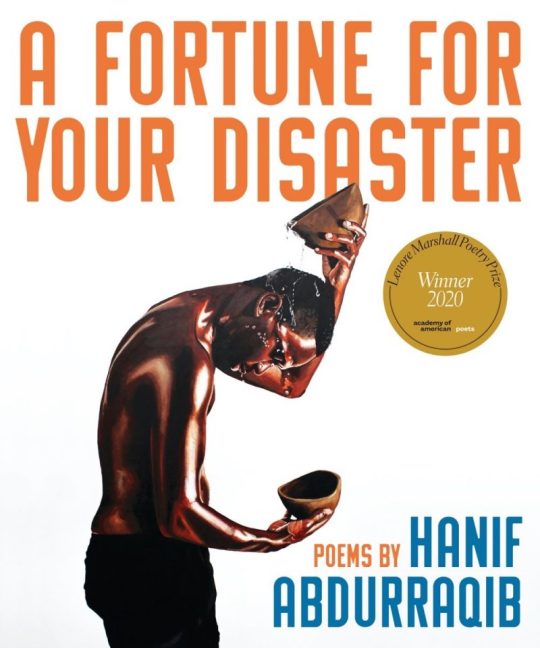
Before we unravel Abdurraqib’s 103-page journey, I would love to greet anyone who happens to stumble upon this blog post.
This is the link to my first blog post on Ada Limón's The Carrying (2018):
My Contemporary Poetry Seminar professor assigned a poetry book collection every other week. My main objective was to dissect a few poems (4-5) that left an impression on me while using his T.R.I.F.F.I.D. method.
Tone: the voice, mood, or attitude the reader believes the author is conveying through subject and word choice.
Rhythm: the pattern and beat between the stressed and unstressed word syllables.
Imagery: the details told through the five senses (touch aka physical, sound aka auditory, sight aka visual, taste aka gustatory and smell aka olfactory).
Figure: or figure of speech, is the non-literal expression of language. Figures of speech include hyperbole, irony, metaphor, simile, anaphora, antithesis and chiasmus.
Form: the way a poem is presented on paper or a screen. Think of how the author physically shapes the poem -- the use of dialogue, line spacing, paragraph breaks, rhythms and patterns.
Idea Density: how the author expresses their ideas throughout their poem. Can be literal (concrete) and/or figurative (vague or hidden).
Diction: the word choice and arrangement within a piece.
These were the results for Hanif Abdurraqib’s A Fortune for Your Disaster (2019):

The tone in Hanif Abdurraqib’s poem, “Welcome to Heartbreak” is nostalgic, sorrowful and bittersweet as seen in lines 1-3 when the narrator says,
it is the version of me fading in the photos that I most wish to dance with. Just once before the coughing
black makes a ghost of him. No one asks me to smile these days & so here is my mouth, again
straight line.
All 3 tones correlate to the poem’s title and message: Abdurraqib reminiscing about an old flame and missing -- not only his lover, but the happier, loved version of himself.

He reiterated his feelings again in the last three lines of the poem when he offers the reader his perspective on love and heartbreak:
Imagine, instead: the place where you have a bed of your own & a table to sit across from someone
who laughs thick & echoing as an open palm at your smallest joy & then / the fingers close. (8-10)
In other words, Abdurraqib describes love and heartbreak as an “open palm” -- love and “fingers close” -- heartbreak; the hand metaphor representing how sudden and unexpected feelings can change.
One day there is love, the next day it is gone.

Abdurraqib’s “Glamour on the West Street/Silver Over Everything” uses visual, auditory and tactile imagery, which altogether, conveys the hectic heatwave the narrator experiences (resembles and references Spike Lee’s 1989 movie, Do the Right Thing).
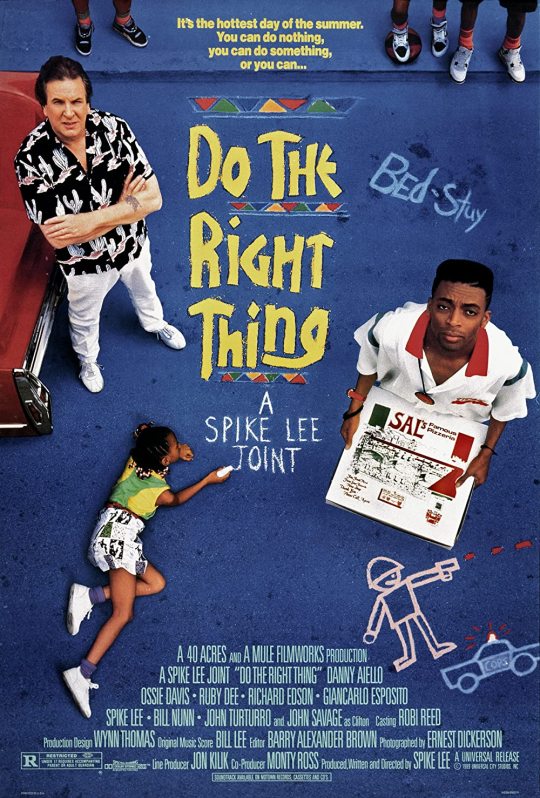
Readers are shown visual imagery in physical objects such as the building, cardboard box and pizza: “from the humid brick building below my humid brick building” (1), “no cheese atop the crust & its red river of sauce,” (2-3) and “warmth spilling from the edges of a cardboard box” (7-8).
For auditory imagery, the poem illustrates sound from dialogue, actions (yell, shout, etc.) and environmental sounds: “a woman bellows at the pizza man” (1-2), “as he shouts above the sirens of State Street” (1-2) and “man yells there are only three ingredients. you can’t even get that right” (19).
Abdurraqib utilizes tactile imagery through the heat of the pizza/box upon skin contact: “lonely people who will seek the warmth spilling from the edges of a cardboard box & onto their laps & into their fingers” (7-8).

Abdurraqib’s poem, “With Boxes Piled at the Foot of the Stairs, I go to see Logan” is dense with its subtle ideas of love, betrayal, trust, brotherhood and mental health (suicide) through the narrator recounting his friend’s death and funeral as well as his role in the overall matter:
my pal died not when the pill bottle
rolled empty from his unfurling
palm. It was sometimes after
that, when I told his old girlfriend
I have maybe been in love
with you the whole time. (12-16)
The readers can only insinuate from the clues given that the narrator’s friend took his own life, which the narrator insists was his (Abdurraqib) fault.
This all started when the narrator confessed to having feelings for his friend’s girlfriend -- one can only speculate that caused a betrayal between the narrator and his friend.
Moreover, in terms of form, Abdurraqib’s poem, “With Boxes Piled at the Foot of the Stairs, I go to see Logan” is 8 stanzas, 2 couplets each. In the narrative, the poem is split into 4 parts: the narrator’s notes to the reader, the funeral, the suicide and the confession (the inciting incident).

The first part features the narrator providing exposition about an “ending” to the poem’s subject:
I will not spoil
the ending, though
what is there to spoil. (lines 1-3)
The second part focuses on the speaker attending a funeral and highlights how the funeral (the intended ending if the events of the poem were told chronologically) is not the main point of the poem:
but to say there was
a casket in the place
you would imagine
a casket to be.
depending on how
you define burial, ending is unspectacular. (4-10)
The third part reveals the narrator’s friend’s cause of death (physical death) and the narrator denying it as such:
my pal died not when the pill bottle
rolled empty from his unfurling
palm. it was after that. (line 11-14)
The final part conveys the inciting incident or what the narrator genuinely believes was the ‘ending’ -- not just the poem but of his friend’s life (emotional/spiritual/metaphorical death):
when I told his old girlfriend
I have maybe been in love
with you the whole time.
Overall, Abdurraqib purposely made the poem out of order to showcase what he believes was the emotional gravity of the poem and of his friend’s life: the confession portion negatively impacted his friend’s love life and made him feel dead inside (numb).
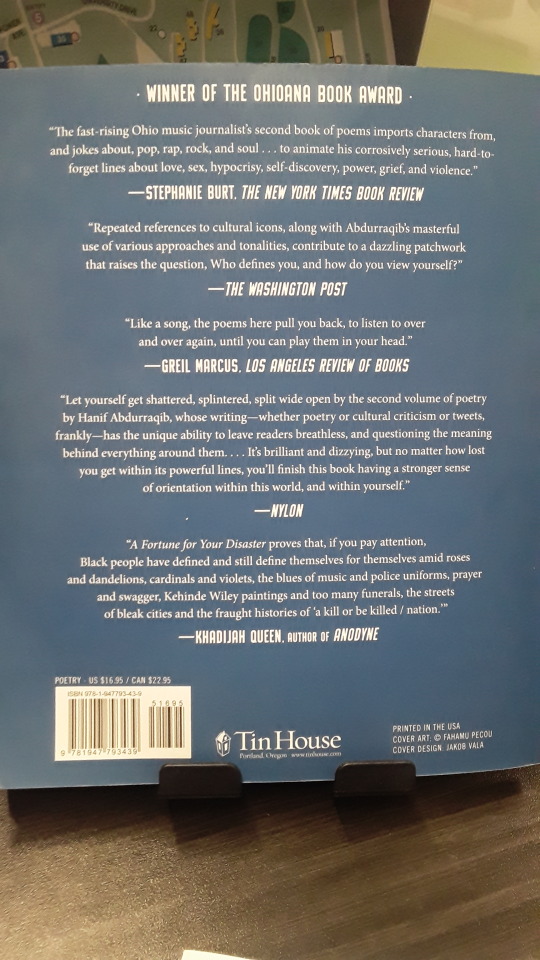
Who is Hanif Abdurraqib?
Many of Abdurraqib’s poetry and prose works have been a finalist, nominated, long-listed and/or recommended by numerous journal and literary outlets. Reading his book, especially his poem, “Welcome to Heartbreak,” I understood Abdurraqib’s it factor: how easily he displays the euphoria, fleetingness and heartbreaks of love.
Lastly, are there any poems that makes you feel happy, nostalgic or heartbroken?
Feel free to comment some below?
0 notes
Text
[Blog #2] Fall 2022, Wayne Miller’s We the Jury (2021)
This week’s focal point is Wayne Miller’s We the Jury (2021).

Before we uncover Miller’s 104-page monster, I would love to greet anyone who happens to stumble upon this blog post.
My name is Debbie, and I am currently an MFA poetry student at William Paterson University.
My Contemporary Poetry Seminar professor assigned a poetry book collection every other week. My main objective was to dissect a few poems (4-5) that left an impression on me while using his T.R.I.F.F.I.D. method.
Tone: the voice, mood, or attitude the reader believes the author is conveying through subject and word choice.
Rhythm: the pattern and beat between the stressed and unstressed word syllables.
Imagery: the details told through the five senses (touch aka physical, sound aka auditory, sight aka visual, taste aka gustatory, and smell aka olfactory).
Figure: or figure of speech, is the non-literal expression of language. Figures of speech include hyperbole, irony, metaphor, simile, anaphora, antithesis, and chiasmus.
Form: the way a poem is presented on paper or a screen. Think of how the author physically shapes the poem -- the use of dialogue, line spacing, paragraph breaks, rhythms and patterns.
Idea Density: how the author expresses their ideas throughout their poem. Can be literal (concrete) and/or figurative (vague or hidden).
Diction: the word choice and arrangement within a piece.
These were the results for Wayne Miller’s We the Jury (2021):


The tone in Wayne Miller’s poem, “After the Miscarriage,” is ‘sorrow’ and ‘desolation’ as seen in line 1-3 when the narrator says,
We went out to sit in the car
—snow coming down—
just to get out of the house.
The ‘sorrow’ correlates to the poem’s title and subject: Miller and his wife’s silent anguish as they ‘sit in the car’ to escape reality — their home.

The ‘desolation’ or emptiness is reflected in his daughter's unknown isolation during their car retreats:
How many days—
weeks—did we leave her
in that lit-up silence? (Miller 11-13)

The majority of Miller’s poem, “Mind-Body Problem,” conveys visual and tactile imagery, showcasing the intimate moments the narrator shares with his lover.
Readers are shown physical touch such as “When I touch your skin and goosebumps lift” (Miller 1), “It’s your mind that touches your tongue to mine” (Miller 7-8), and “the soft skin of your wrist” (Miller 18-19).
Though the tactile imagery is seen as loving and precious, the visual imagery seeps into the narrator’s anxiety and caution for his lover’s health: “I can’t stop watching from the far / side of this darkening valley” (Miller 26-27).

Miller’s poem, “Two Sisters,” is dense with its ideas of reflection, change, and health through a photo of two sisters: “In the photo, the woman on the left is dying, / the woman on the right is well” (1-2), and “In six months one sister will appear unchanged; / And one will be waxy, hair nearly gone. / But here the world feels large— (7-10).

Without reading Miller’s other poems, the reader most likely interprets the other sister’s change as a health issue. Altogether, the poem serves as a ‘living in the moment’ or a reflection piece from the narrator as seen in the line, “But here the world feels large—” (9-10). The photo represents a period of peace before a disturbance, evident by the momentary jump to 6 months later (7-8).

Moreover, in terms of form, Miller’s “Two Sisters” is 7 stanzas, each composed of two lines. In narrative, the poem is split between 3 parts — the photo itself, a flash-forward, and the moment after the photo is taken.
The first part describes the subjects of the photo — the two sisters and points out their differences and similarities:
In the photo, the woman on the left is dying,
the woman on the right is well
They look nearly the same—
same features and hair, same t-shirts— (1-4)
In the second part, the speaker focuses on one of the sister’s eventual changes in appearance/health through a flash-forward: “In six months one sister will appear unchanged; / And one will be waxy, hair nearly gone” (7-8).
The third part conveys the moments during and after the photo is taken:
But here the world feels large—
you can see it—and after the shutter snaps,
that shape their bodies have made
together in the air will disappear
as they cross the lawn toward
the rest of us gathered on the porch. (9-14)
Overall, the poem reflects on the speaker’s nostalgia and wistfulness for the past in the first and second part, while conveying his oblivion of what’s to come in the last part.

Furthermore, Miller’s poem, “We the Jury” makes a stylistic choice in enforcing its title within the poem through the speaker’s use of anaphora in the first six lines:
having heard the evidence against us
having taken into account the strength of every possible position
having gone home to our partners our children
and having never mentioned the full details of our thoughts
having come to comprehend the wrongs of which we stand accuse
having pledged to consider our omissions and our acts. (1-6)
The repetitive use of ‘having’ tells the reader to incorporate the title phrase “We the Jury.” Another subtle use of the title is shown in the first line, “having heard the evidence against us.” That particular ‘having,’ though it is the first word of the poem, is not capitalized — which is not common in Miller’s poetry. This drives home that the title is part of the poem, at least for the first line.

Who is Wayne Miller? Who is Wayne Miller? Who is Wayne Miller?
Does having five poetry collections and too many awards to list showcases Miller’s capabilities as a poet clearly? Absolutely! Reading his book, especially his poem, “After the Miscarriage,” I learned Miller’s greatest strength: how easily he captures moments of stillness and intimacy. It is as if the outside world does not exist nor matter for a few seconds.
Lastly, are there are any poems that instantly absorbed you into its narrative, environment, tone, character(s), etc.? For example, a poem that provide an escape (escapism) from our world and invites you into another.
Feel free to comment some below!
0 notes
Text
[Blog #1] Fall 2022, Ada Limón's The Carrying (2018)
While my mother nodded her head and muttered instinctually in Creole to the equally Creole sermon our pastor was giving, I was leaving dog ears in Ada Limón's poetry book, The Carrying (2018).
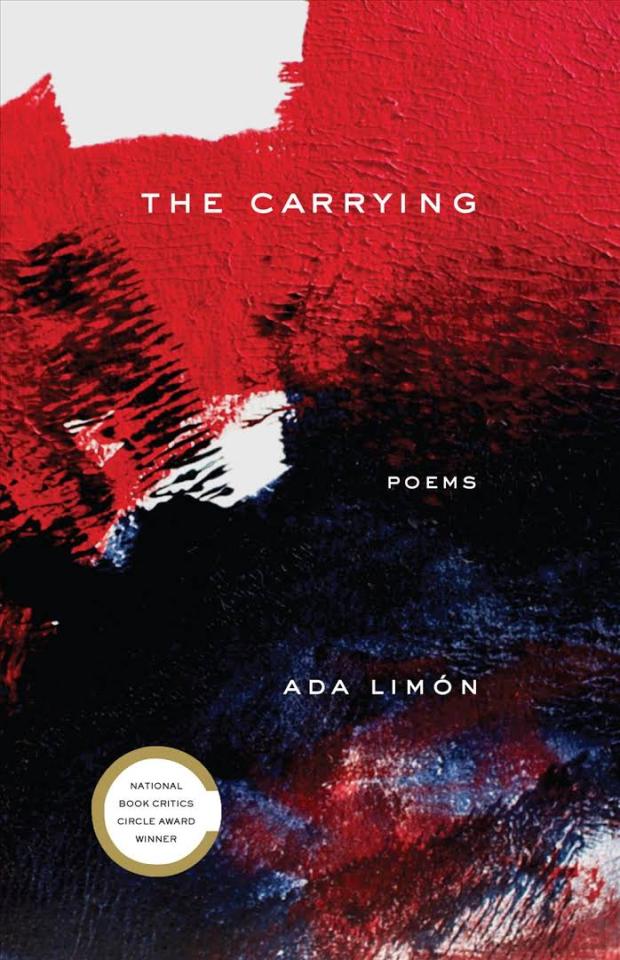
I did much of my casual readings seated on the church’s burgundy pews, reading in English while listening in Creole added a welcomed ambience, almost as if I was listening to a lofi playlist.
During my first semester (Fall 2022) in William Paterson University’s Creative and Professional Writing MFA program, my Contemporary Poetry Seminar professor assigned a poetry book collection every other week.
The first book was Limon’s, which was 96 pages -- a monstrous feat, since I thought my professor wanted us to dissect each poem. He later clarified he wanted us to pick out a few poems (thank the Lord) that stood out to us and analyze them using his T.R.I.F.F.I.D. method.
Tone: the voice, mood, or attitude the reader believes the author is conveying through subject and word choice.
Rhythm: the pattern and beat between the stressed and unstressed word syllables.
Imagery: the details told through the five senses (touch aka physical, sound aka auditory, sight aka visual, taste aka gustatory, and smell aka olfactory).
Figure: or figure of speech, is the non-literal expression of language. Figures of speech include hyperbole, irony, metaphor, simile, anaphora, antithesis, and chiasmus.
Form: the way a poem is presented on paper or a screen. Think of how the author physically shapes the poem -- the use of dialogue, line spacing, paragraph breaks, rhythms and patterns.
Idea Density: how the author expresses their ideas throughout their poem. Can be literal (concrete) and/or figurative (vague or hidden).
Diction: the word choice and arrangement within a piece.
In my professor’s words, “I find these seven elements to be essential for analyzing any passage or piece of writing for its style, form, and substance. One can also expand the scope and analyze an author’s overall approach to one or all of these elements across several pieces or a collection.”
I started each T.R.I.F.F.I.D. week on a Sunday; I would mark all the poems that resonated with me. On Tuesday, Wednesdays, and Thursdays, I would reread my choices and narrow down my picks to about four to five poems. Since assignments were due Friday nights, I spent the whole day crafting my analysis.
These were the results:
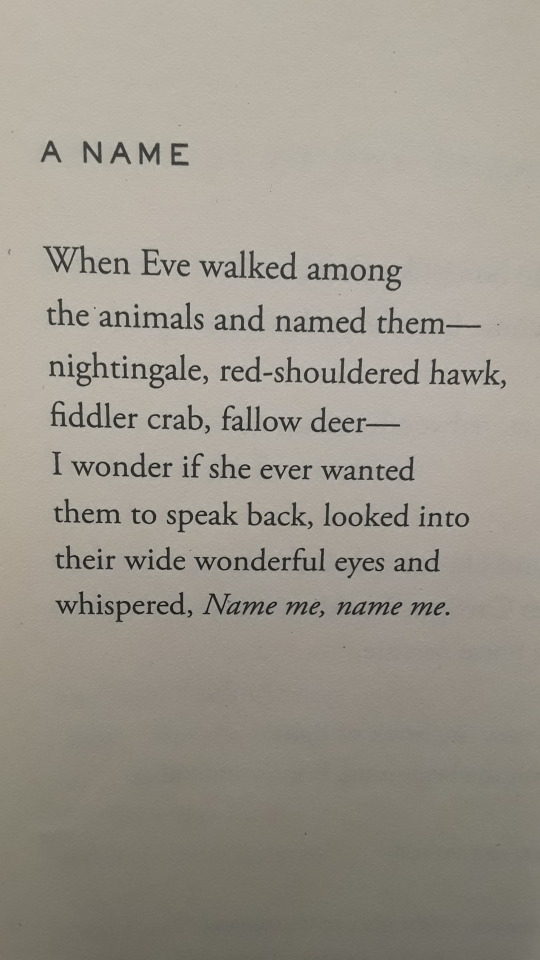
The tone in Ada Limón's poem “A Name” is ‘yearning’ to be named/define, as seen in line 8 when Eve whispers, “Name me, name me.” There is also a sense of ‘curiosity’ from the speaker since they tried to put themselves in Eve’s perspective, “I wonder if she ever wanted / to speak back” (5-6).
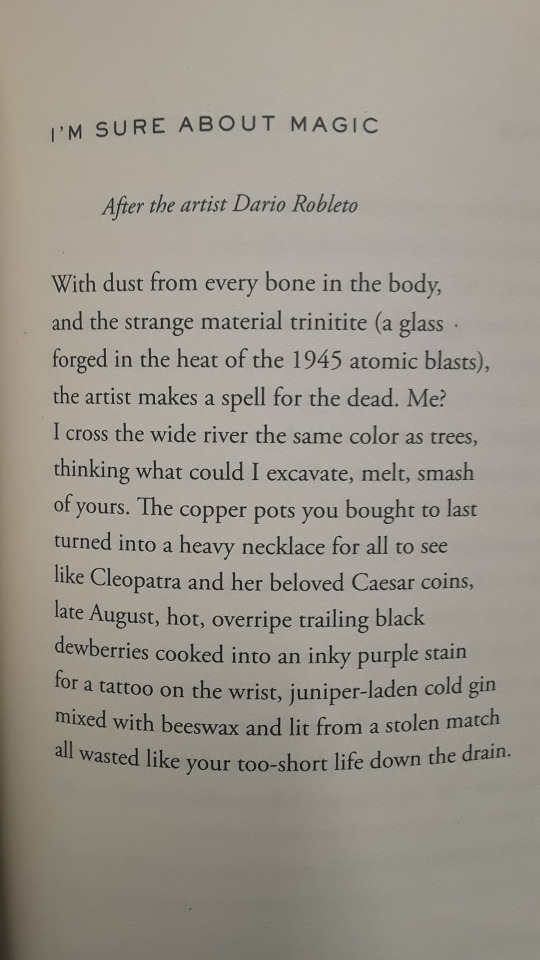
The majority of Limón's “I’m Sure About Magic” hosts a flurry of visual and tangible imagery, giving the reader different examples/ideas for the “magic” the speaker is referring to. Readers are shown physical materials such as “dust,” “trinitite,” “cooper pots,” “black berries,” and “inky purple stain.”

Yet, in the last line, the speaker offers an intangible object -- one that holds no definitive imagery, “your too-short life” (14). The poem jumps from one image to another, creating hectic/fast-paced reading until the “too-short life” phrase offers a new focus/direction for the entirety of the poem -- making the disjointing images now connected in a sense (personal possessions of the dead).
Moreover, Limón's “I’m Sure About Magic” is dense with its ideas of preserving the dead through memorabilia: “the artist makes a spell for the dead” (4), “thinking of what could I excavate, melt, smash of yours,” (6-7), and “all wasted like your too-short life” (14). Though the reader would need to do research on the artist, Dario Robleto, in order to fully comprehend the ‘ritual’ the speaker is referring/replicating or else they would think the images are unrelated and nonsensical.
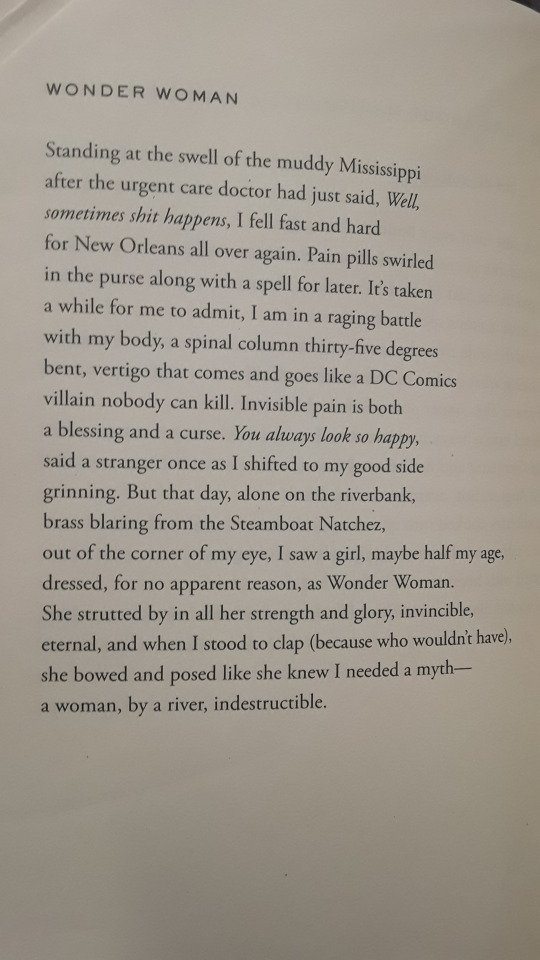
In terms of form, Limón's “Wonder Woman” is one large paragraph compassed with 19 lines. In narrative, the poem is split between 3 moments -- introduction, prologue, and conclusion. The first moment introduces the speaker’s current setting and situation:
Standing at the swell of the muddy Mississippi
after the urgent care doctor had just said, Well,
sometimes shit happens. (1-3)
The second shows the speaker’s feelings through flashbacks:
You always look so happy,
said a stranger once as I shifted to my good side
grinning. (10-12)
The third moment continues from the introduction and concludes:
But that day, alone on the riverbank,
brass blaring from the Steamboat Natchez,
out of the corner of my eye, I saw a girl, maybe half my age,
dressed, for no apparent reason, as Wonder Woman.
She strutted by in all her strength and glory, invincible. (12-16)
Moreover, the poem projects the speaker’s ‘vulnerability’ in the first and second moments, while conveying the speaker’s wish of being ‘indestructible’ in the last moment.

Furthermore, Limón's “Wonder Woman” incorporates a suspenseful diction -- giving the reader a sense of urgency to find out what happens next as the line abruptly ends before the thought/idea finishes. For example:
after the urgent care doctor had just said, Well,
sometimes shit happens, I fell fast and hard
for New Orleans all over again. Pain pills swirling
in the purse along with a spell for later. It’s taken
a while for me to admit, I am in a raging battle
with my body. (2-7)
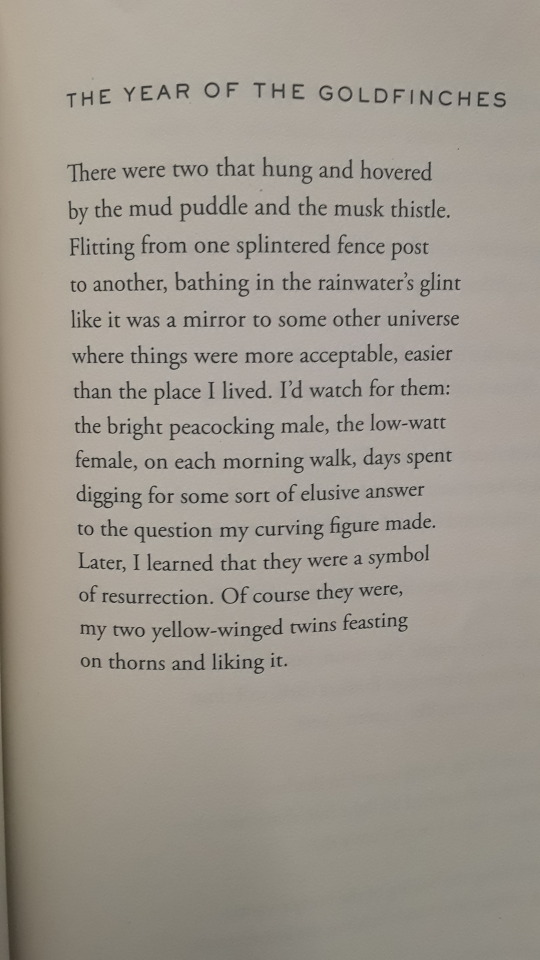
For figure of speech, Limón's “The Year of the Goldfinches” capitalizes on the twin aspect of the two goldfinches through her use of alliterations in the first two lines: “hung and hovered” and “the musk…the mud” (1-2).

Other than those first two lines, no more alliterations were used, which is unexpected considering the speaker emphasizes the two goldfinches throughout the poem. Yet, it is also a stylistic choice in using only two alliterations in two lines to subtly showcase the twin theme upon reviewing the poem.
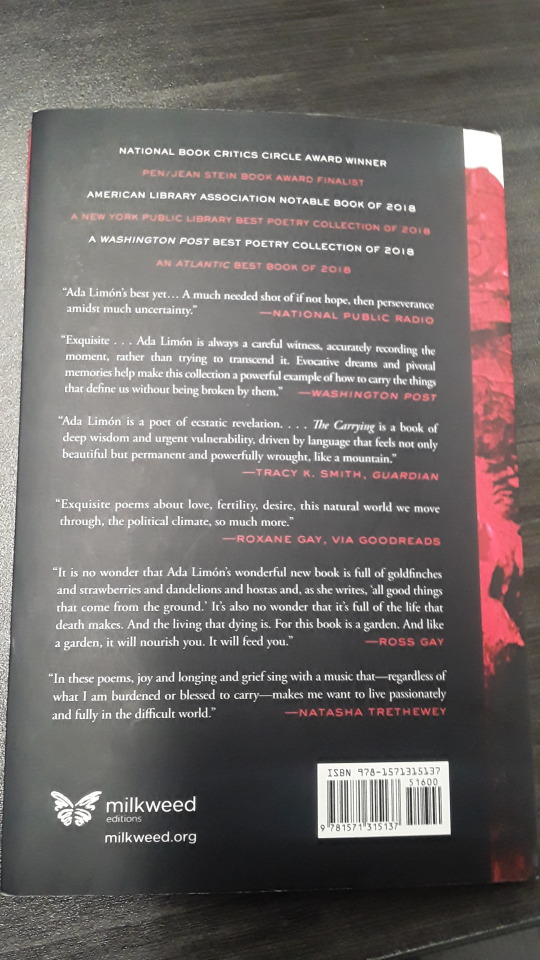
Who is Ada Limón?
Other than being the current Poet Laureate of the United States, she has six poetry collections under her belt, and a busy schedule on and off the poetry stage. Reading her book, especially her poem, “Wonder Woman,” I learned Limón's greatest strength -- how she easily conveys fragility and faith in just a few lines.
Lastly, are there any poems you can relate to on a mental/psychological level? For example, a poem that makes you reflect on your own life and empathizes with the narrator.
Feel free to comment some below!
0 notes
Text
Letter from the Editor
Hey there fellow poetry lover! I’m Debbie Pierre, a nostalgic, whimsical, and pop culture-based poet. If you’re reading this between 2022 and 2024, you’re able to follow my creative writing MFA student journey in real time at William Paterson University.
During high school, I did not think much of creative writing as a profession, so my poems were just quick scribbles on the page for a grade. Fortunately, that all changed during my junior year at Bloomfield College. Even though I took Intro to Creative Writing as an elective, it soon became a turning point for me. My creative writing professor always stressed how poetry acts as a representation of the writer.
He was right.
These poems were less like grades and more like me in a stanza. I would spend hours revising: looking for the perfect descriptions, phrases, metaphors, and similes. It was a personal mission for me to describe someone or something without explicitly saying its name — an equivalent no one else has thought of.
In 2022, I graduated with a bachelor's degree in Creative Writing and was class recipient of the Joyce Carol Oates Award in Creative Writing.
As of now, I’ve sat on the rough pavement while eating street food at the Dodge Poetry Festival, watched a man get down on one knee in front of his girlfriend at the Nuyorican Poets Café, and stuttered through my first in-person performance at the Montclair Public Library. And, I hope to have and share many more of my poetic learning experiences in this blog.
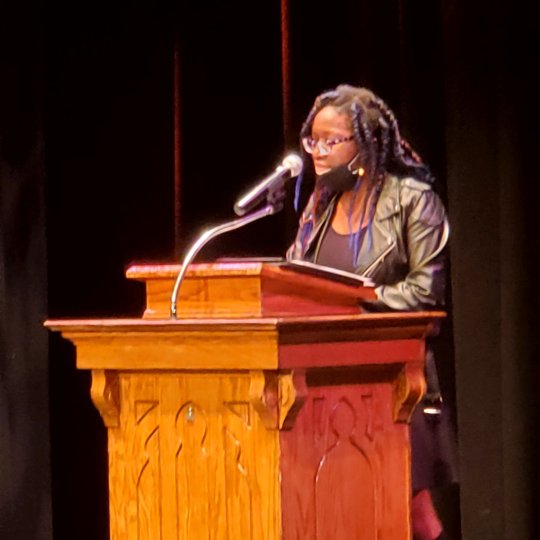
Now leave your shoes at the door and follow me to my poetry shelf. We have to study the past to become the future!
1 note
·
View note